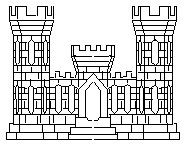
CASTLE

The appropriateness of the turreted castle as a symbol of the Army Corps of Engineers is readily apparent. The medieval castle is inseparably connected with fortifications and architecture. In heraldry, the castle and the tower are often used on coats of arms or given as charges in the shield of individuals who overcome walled fortifications, were the first to mount their walls ore successfully defended them. In this country the term "castle" has been applied to the strongest of our early fortifications such as Castle Pickney in Charleston, South Carolina, and Castle Williams and Clinton in New York Harbor. The Castle is a highly stylized form without decoration or embellishment. The Army officially adopted the castle to appear on the Corps of Engineers Epaulets and belt plate, in 1840. Soon afterwards the cadets at West Point, all of whom were part of the Corps of Engineers until the Military Academy left the charge of the Chief of Engineers and came under the charge of the Army at Large in 1866, also wore the castle on their cap beginning in 1841. Subsequently the castle appeared on the shoulder knot; on the saddle cloth, as a collar device, and on the buttons. Although its design has changed many times since its inception, the castle has remained the distinctive symbol of the Corps of Engineers.